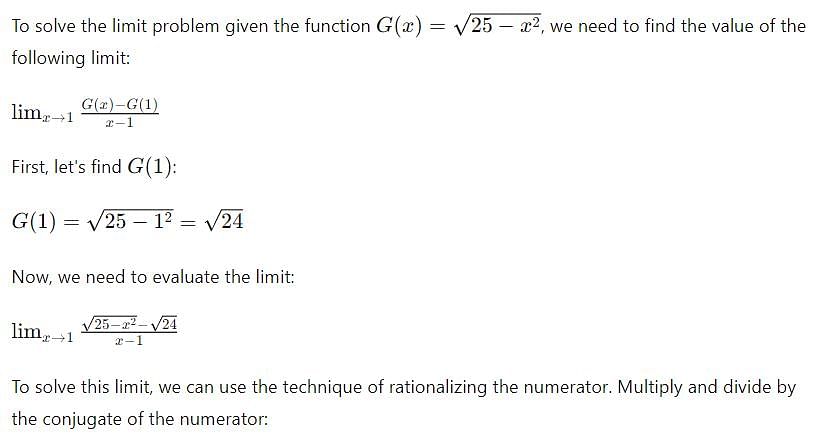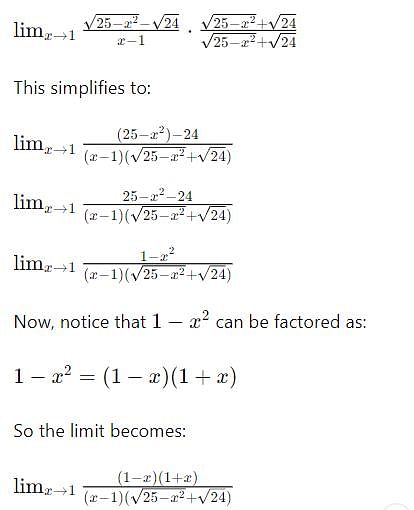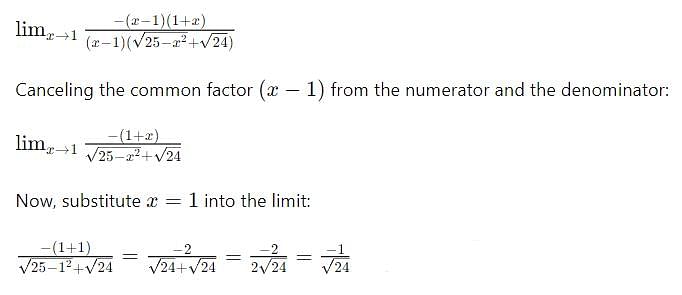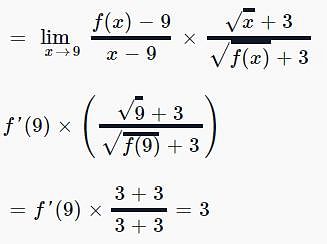JEE Exam > JEE Tests > Mathematics (Maths) for JEE Main & Advanced > Test: Limits And Derivatives - 2 - JEE MCQ
Test: Limits And Derivatives - 2 - JEE MCQ
Test Description
25 Questions MCQ Test Mathematics (Maths) for JEE Main & Advanced - Test: Limits And Derivatives - 2
Test: Limits And Derivatives - 2 for JEE 2024 is part of Mathematics (Maths) for JEE Main & Advanced preparation. The Test: Limits And Derivatives - 2 questions and answers have been
prepared according to the JEE exam syllabus.The Test: Limits And Derivatives - 2 MCQs are made for JEE 2024 Exam. Find important
definitions, questions, notes, meanings, examples, exercises, MCQs and online tests for Test: Limits And Derivatives - 2 below.
Solutions of Test: Limits And Derivatives - 2 questions in English are available as part of our Mathematics (Maths) for JEE Main & Advanced for JEE & Test: Limits And Derivatives - 2 solutions in
Hindi for Mathematics (Maths) for JEE Main & Advanced course. Download more important topics, notes, lectures and mock
test series for JEE Exam by signing up for free. Attempt Test: Limits And Derivatives - 2 | 25 questions in 25 minutes | Mock test for JEE preparation | Free important questions MCQ to study Mathematics (Maths) for JEE Main & Advanced for JEE Exam | Download free PDF with solutions
Detailed Solution for Test: Limits And Derivatives - 2 - Question 1
Detailed Solution for Test: Limits And Derivatives - 2 - Question 2
| 1 Crore+ students have signed up on EduRev. Have you? Download the App |
Detailed Solution for Test: Limits And Derivatives - 2 - Question 4
Detailed Solution for Test: Limits And Derivatives - 2 - Question 6
Test: Limits And Derivatives - 2 - Question 8
If f be a function such that f (9) = 9 and f ‘ (9) = 3, then  is equal to
is equal to
Detailed Solution for Test: Limits And Derivatives - 2 - Question 8
Detailed Solution for Test: Limits And Derivatives - 2 - Question 10
Detailed Solution for Test: Limits And Derivatives - 2 - Question 12
Test: Limits And Derivatives - 2 - Question 21
The derivative of sec-1  with respect to
with respect to  at x = 1/x is
at x = 1/x is
|
209 videos|443 docs|143 tests
|
Information about Test: Limits And Derivatives - 2 Page
In this test you can find the Exam questions for Test: Limits And Derivatives - 2 solved & explained in the simplest way possible.
Besides giving Questions and answers for Test: Limits And Derivatives - 2, EduRev gives you an ample number of Online tests for practice
|
209 videos|443 docs|143 tests
|
Download as PDF


 is equal to
is equal to 


 is equal to
is equal to
 then
then  has the value
has the value


 then dy/dx is equal to
then dy/dx is equal to


 is equal to
is equal to  , x ∈ (0,1), then f'(x) is equal to
, x ∈ (0,1), then f'(x) is equal to 
 then dy/dz =
then dy/dz =  is equal to
is equal to  and f(a) = 0, is
and f(a) = 0, is  is equal to
is equal to  is equal to
is equal to  then dx/dy is equal to
then dx/dy is equal to  holds true for
holds true for w.r.t
w.r.t  is
is then
then 
 is equal to
is equal to is eqaual to
is eqaual to  then dy/dx =
then dy/dx =  then at x = 1, f(x) is
then at x = 1, f(x) is














